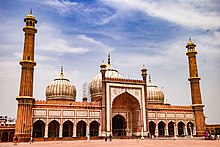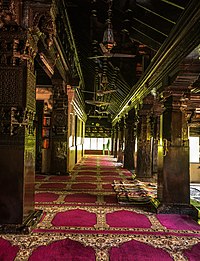
Back الإسلام في الهند Arabic ভারতে ইসলাম Bengali/Bangla Islam sa indya CEB ئیسلام لە ھیندستان CKB Islám v Indii Czech Islam in Indien German Ισλάμ στην Ινδία Greek Islamo en Barato Esperanto اسلام در هند Persian Islam en Inde French
Editing of this article by new or unregistered users is currently disabled. See the protection policy and protection log for more details. If you cannot edit this article and you wish to make a change, you can submit an edit request, discuss changes on the talk page, request unprotection, log in, or create an account. |
Editing of this article by new or unregistered users is currently disabled due to vandalism. See the protection policy and protection log for more details. If you cannot edit this article and you wish to make a change, you can submit an edit request, discuss changes on the talk page, request unprotection, log in, or create an account. |
 | |
| Total population | |
|---|---|
| c. 200 million (14.61% of the population)[2] (2021 Census est.) | |
| Regions with significant populations | |
| Uttar Pradesh | 38,483,970[3] |
| West Bengal | 24,654,830[3] |
| Bihar | 17,557,810[3] |
| Maharashtra | 12,971,150[3] |
| Assam | 10,679,350[3] |
| Kerala | 8,873,470[3] |
| Jammu and Kashmir | 8,567,490[3] |
| Andhra Pradesh (includes present-day Telangana) | 8,082,410[3] |
| Karnataka | 7,893,070[3] |
| Rajasthan | 6,215,380[3] |
| Religions | |
| Majority Sunni Islam with significant Shia and Ahmadiyya minorities[4] | |
| Languages | |
Liturgical
| |
| Part of a series on |
| Islam in India |
|---|
 |
| Islam by country |
|---|
 |
|
|
Islam is India's second-largest religion, with 14.2% of the country's population, or approximately 172.2 million people, identifying as adherents of Islam in a 2011 census.[7] India also has the third-largest number of Muslims in the world.[8][9] The majority of India's Muslims are Sunni, with Shia making up around 15% of the Muslim population.[10]
Islam spread in Indian communities along the Arab coastal trade routes in Gujarat and in Malabar Coast shortly after the religion emerged in the Arabian Peninsula. Islam arrived in the inland of Indian subcontinent in the 7th century when the Arabs invaded and conquered Sindh and later arrived in Punjab and North India in the 12th century via the Ghaznavids and Ghurids conquest and has since become a part of India's religious and cultural heritage. The Barwada Mosque in Ghogha, Gujarat built before 623 CE, Cheraman Juma Mosque (629 CE) in Methala, Kerala and Palaiya Jumma Palli (or The Old Jumma Masjid, 628–630 CE) in Kilakarai, Tamil Nadu are three of the first mosques in India which were built by seafaring Arab merchants.[11][12][13][14][15] According to the legend of Cheraman Perumals, the first Indian mosque was built in 624 CE at Kodungallur in present-day Kerala with the mandate of the last ruler (the Tajudeen Cheraman Perumal) of the Chera dynasty, who converted to Islam during the lifetime of Prophet Muhammad (c. 570–632). Similarly, Tamil Muslims on the eastern coasts also claim that they converted to Islam in Muhammad's lifetime. The local mosques date to the early 700s.[16]
- ^ "Muslim population in 2023 estimated to be 20 crore: Lok Sabha". The Times of India. 21 July 2023.
- ^ "Can Muslims surpass Hindus in population numbers? Experts say practically not possible".
- ^ a b c d e f g h i j "India - Muslim population 2011". Statista. Retrieved 20 February 2020.
- ^ "World Directory of Minorities and Indigenous Peoples - India : Muslims".
- ^ Al-Jallad, Ahmad (30 May 2011). "Polygenesis in the Arabic Dialects". Encyclopedia of Arabic Language and Linguistics. BRILL. doi:10.1163/1570-6699_eall_EALL_SIM_000030. ISBN 9789004177024.
- ^ "Why the 30% Muslim vote share is crucial in Bengal, explains Robin Roy". Free Press Journal. Retrieved 8 November 2021.
- ^ "Religion PCA – India". 2011 Census of India. Retrieved 26 October 2021.
"Religion PCA". Census of India Website : Office of the Registrar General & Census Commissioner, India. Retrieved 1 September 2021. - ^ "The countries with the 10 largest Christian populations and the 10 largest Muslim populations". Pew Research Center. Retrieved 17 June 2019.
- ^ Pechilis, Karen; Raj, Selva J. (1 January 2013). South Asian Religions: Tradition and Today. Routledge. p. 193. ISBN 9780415448512.
- ^ Cite error: The named reference
USSD-IRFRwas invoked but never defined (see the help page). - ^ Prof. Mehboob Desai,Masjit during the time of Prophet Nabi Muhammed Sale Allahu Alayhi Wasalam, Divy Bhasakar, Gujarati News Paper, Thursday, column 'Rahe Roshan', 24 May, page 4.
- ^ Kumar(Gujarati Magazine), Ahmadabad, July 2012, P. 444.
- ^ "Oldest Indian mosque: Trail leads to Gujarat". The Times of India. 6 November 2016. Archived from the original on 16 November 2016. Retrieved 28 July 2019.
- ^ "India's oldest mosque and growing irrelevance of Muslim vote in Gujarat". The Times of India. 8 December 2017. Archived from the original on 9 December 2017. Retrieved 28 July 2019.
- ^ Sharma, Indu (22 March 2018). "Top 11 Famous Muslim Religious Places in Gujarat". Gujarat Travel Blog. Retrieved 28 July 2019. [verification needed]
- ^ Metcalf, Barbara D. (2009), Islam in South Asia in Practice, Princeton University Press, p. 1, ISBN 978-1-4008-3138-8
